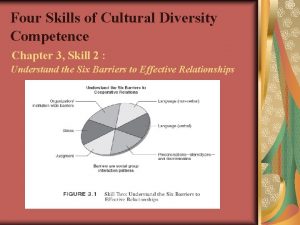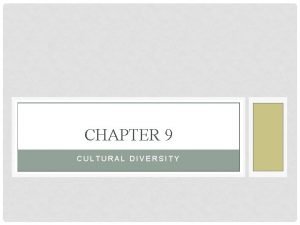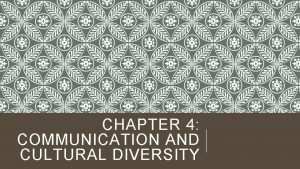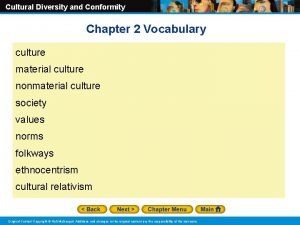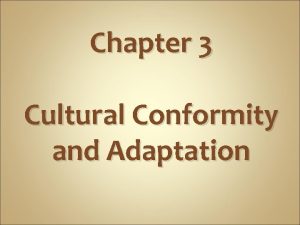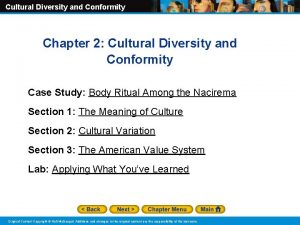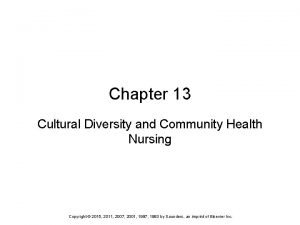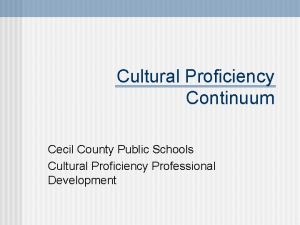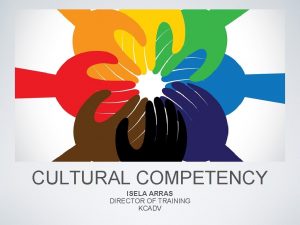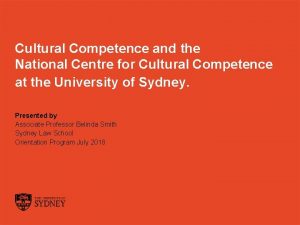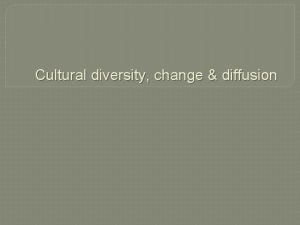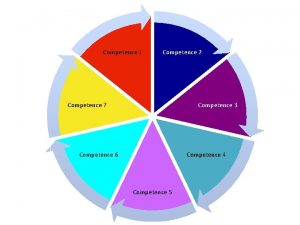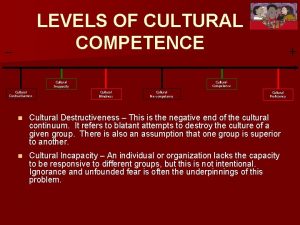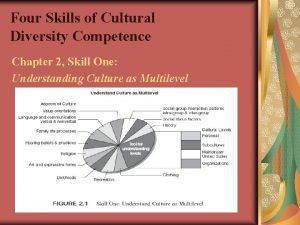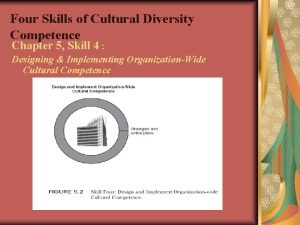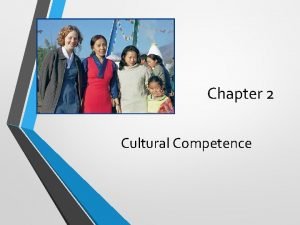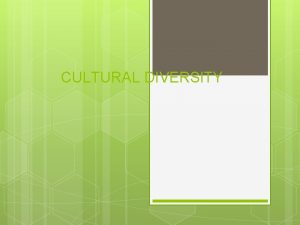Four Skills of Cultural Diversity Competence Chapter 3












- Slides: 12

Four Skills of Cultural Diversity Competence Chapter 3, Skill 2 : Understand the Six Barriers to Effective Relationships

Skill 2: Understand the Six Barriers Personal and Interpersonal Barriers: 1. VERBAL BEHAVIOR: language 2. NONVERBAL BEHAVIOR: greetings, body gestures, eye behavior, vocal cues, body smell, expressions of emotion, time and space orientation, thinking style (linear or holistic) 3. STEREOTYPES and DISCRIMINATION: misinformation, missing information, and overgeneralizing; stereotypes provide psychological permission for discrimination 4. JUDGMENT: negative thoughts and feelings that accompany stereotypes 5. STRESS: the discomfort felt in culturally diverse situations. It is useful to examine stress in terms of layers Organizational/Institutional Barriers: 6. Organization norms, policies, procedures, and programs unfriendly to cultural diversity

Skill 2, 5 th Barrier: Stress LEVELS OF STRESS 1. General Stress is experienced in relation to the following: HEALTH , FAMILY, WORK and or SCHOOL, FINANCES, ENVIRONMENT 2. Stress Among People of Minority Status is experienced in relation to the above listed factors in addition to the following: INVISIBILITY SOCIAL EXCLUSION REJECTION PRESSURE TO PROVE ONESELF DENIAL OF ONE'S EXPERIENCE VERBAL AND PHYSICAL HARASSMENT AND OR ASSAULT 3. Stress Among People of Immigrant Status includes all of the above stressors in addition to: Culture Shock Acculturation Stress

Skill 2: The Six Barriers Worksheet # 11, Barriers to Communication: Cross-Cultural Speaking, pages 65 -66 Purpose: To foster awareness and understanding of the verbal and nonverbal barriers in communication in a culturally diverse context

Skill 2: The Six Barriers Worksheet # 12, Case of the Green Haired People, pages 67 -69 Purpose: To foster awareness and understanding of the barriers to effective communication and relationships in culturally diverse settings

Skill 2: The Six Barriers 6 TH Barrier ORGANIZATIONALINSTITUTIONAL BARRIERS: norms, policies, procedures, and programs unfriendly to cultural diversity

Skill 2, 6 th Barrier: Organizational Example: Five Common Gender Issues Reported at Work Sites (pages 60 -61): 1. Authority and Expectations 2. Opportunities, Pay, and Benefits 3. Sexual Behavior 4. Etiquette and Language 5. Balancing Work and Home Life

Skill 2: The Six Barriers Five Assumptions of U. S. National Culture about Diversity (they can also be thought of as cultural themes of U. S. National culture) that often times surface in organizations. 1. The U. S. is a meritocracy of equal individuals 2. Americans don’t have a culture, only other people 3. If it is different, it is wrong 4. Never talk about cultural diversity 5. Never admit to being prejudice

Skill 2: The Six Barriers Worksheet 13, Case Analysis of Barriers, pages 71 -72. Purpose: to foster awareness and understanding of the barriers in everyday interactions at home, work, and in the community. First analyze the following case examples with me before you form into small groups.

Skill 2, Case Analysis of Barriers: Examples 1. Case: In conversation among social service workers a comment was made re: “American Indian” : “that person looks about as American Indian as you. ” The person, however, was American Indian, and was offended. 2. Case: New child from Haiti in school, Kids are lining up, and child is unclear as to what to do. Staff says, “Can’t you understand English? You’re in America now” 3. Case: Female staff runs 100 yards to an “assist call. ” Is greeted with, “What are you doing here…we need a man. ” Was very offended. 4. Case In her internship as a counselor, one male client thought she was incompetent because of her age. He didn’t think she was knowledgeable and experienced enough to help him with his problems. In addition, this male client felt that she couldn’t relate to him because she is female. 5. Case Coworker in other department assumed that I only speak Spanish because I am and look Hispanic. She didn’t bother to find out if I speak Spanish (and I don’t).

List of Barriers for Debriefing Case Analysis, (of pgs. 71 -72) Personal and Interpersonal Barriers: 1. VERBAL BEHAVIOR: language 2. NONVERBAL BEHAVIOR: greetings, body gestures, eye behavior, vocal cues, body smell, expressions of emotion, time and space orientation, thinking style (linear or holistic) 3. STEREOTYPES and DISCRIMINATION: misinformation, missing information, and overgeneralizing; stereotypes provide psychological permission for discrimination 4. JUDGMENT: negative thoughts and feelings that accompany stereotypes 5. STRESS: the discomfort felt in culturally diverse situations. It is useful to examine stress in terms of layers Organizational/Institutional Barriers: 6. Organization norms, policies, procedures, and programs unfriendly to cultural diversity

Skill 2: The Six Barriers Worksheet 14, Barriers to Effective Relationships: Case analysis, Part 2, Organization-wide Barriers, (pgs. 73 -74) Purpose: To foster awareness and understanding of organization/institution policy barriers to effective communication and relationships in culturally diverse settings.
 Four skills of cultural diversity competence
Four skills of cultural diversity competence Chapter 9 cultural diversity
Chapter 9 cultural diversity Diversity competency
Diversity competency Chapter 4 communication and cultural diversity
Chapter 4 communication and cultural diversity 2009 delmar cengage learning
2009 delmar cengage learning Cultural diversity and conformity section 1
Cultural diversity and conformity section 1 Cultural diversity and conformity chapter test form a
Cultural diversity and conformity chapter test form a Cultural diversity and conformity section 2
Cultural diversity and conformity section 2 Chapter 13 cultural diversity and community health nursing
Chapter 13 cultural diversity and community health nursing Cultural diversity 3939 answers
Cultural diversity 3939 answers Examples of cultural blindness in schools
Examples of cultural blindness in schools Cultural competence examples
Cultural competence examples National centre for cultural competence
National centre for cultural competence
